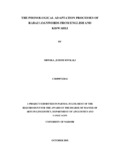| dc.description.abstract | The research aimed at analyzing the phonological adaptation processes of Rabai loanwords from English and Kiswahili within the limits of Optimality theory. It was set out to address the following objectives: (i) To establish the phonemes of the Rabai language (ii) To investigate the phonological adaptation processes in Rabai loanwords borrowed from English and Kiswahili. (iii) To analyze the adaptation of English and Kiswahili syllable structures into the Rabai syllable structure. The investigation focuses only on Rabai language as used in the Rabai Constituency of the Kilifi County of Kenya. The data used in this analysis was gathered from Kombeni and Mkapuni villages of the Rabai Kisurutini Ward of the Rabai Constituency of the Kilifi County of Kenya using questionnaires. Being a preliminary phonological adaptation investigation on Rabai borrowings, it employs the Optimality theory, a theory that has not been used to study any Mijikenda language. The findings point out that the Rabai language has thirty-four cononants and five vowels. In addition, the consonant adaptation processes involved in this study are syncopation, prothesis, metathesis, substitution, epenthesis and apheresis. The adaptation processes that involve vowels are paragoge, anaptyxis, syncopation, apheresis, diphthongization, shortening, monophthongization as well as raising and lowering which result from substitution. Further analysis shows that there are two main adjustments on the syllable structures of English and Kiswahili inputs which are caused by the aforementioned adaptation processes. These adjustments are syllable weight loss and re-syllabification, adjustments which accompany coda elimination and cluster breakage. However, some foreign clusters are retained in Rabai outputs, something which is a weakness of the strongest tenet of the Optimality Theory; the elimination of outputs which violate makedness constraints. | en_US |



